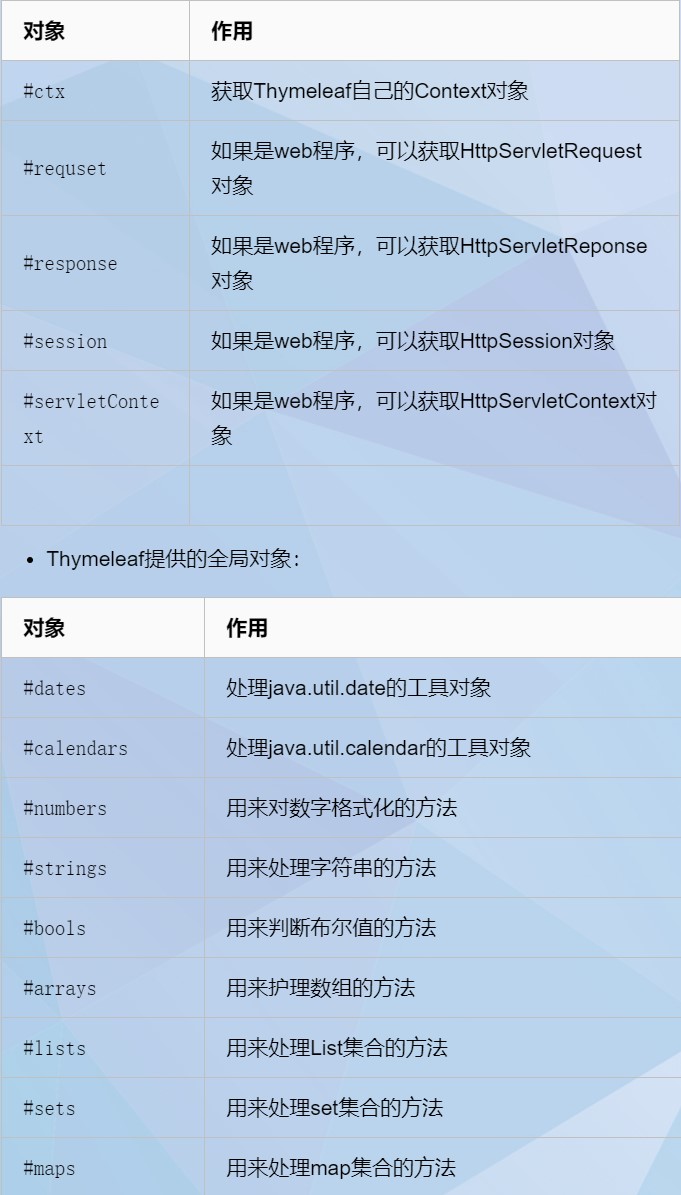Thymeleaf
# Thymeleaf
# 使用准备
导入依赖:
<dependency>
<groupId>org.springframework.boot</groupId>
<artifactId>spring-boot-starter-thymeleaf</artifactId>
</dependency>
2
3
4
首先依然根据 spring-boot-autoconfigure\META-INF\spring.factories,找到 thymeleaf 的配置类 org.springframework.boot.autoconfigure.thymeleaf.ThymeleafAutoConfiguration,并根据 @EnableConfigurationProperties(ThymeleafProperties.class) 注解找到 ThymeleafProperties
@ConfigurationProperties(prefix = "spring.thymeleaf")
public class ThymeleafProperties {
private static final Charset DEFAULT_ENCODING = StandardCharsets.UTF_8;
public static final String DEFAULT_PREFIX = "classpath:/templates/";
public static final String DEFAULT_SUFFIX = ".html";
2
3
4
5
6
7
由此,我们可以在配置文件中使用 spring.thymeleaf 作出相应配置,且默认路径是 classpath:/templates/,后缀为 .html。
注意
templates 目录下的文件必须通过 controller 访问。
在 html 页面中引入约束:
<html lang="en" xmlns:th="http://www.thymeleaf.org">
# 基本语法
thymeleaf 中,HTML 标签的所有元素都由 thymeleaf 接管,要使用 thymeleaf 必须通过 th:xxx 的形式指定属性。
${...}表达式:Thymeleaf 通过
${}来获取 model 中的变量,注意这不是 el 表达式,而是 ognl 表达式,但是语法非常像。@Controller public class TestController { @RequestMapping("/test") public String hello(Model model){ Student student=new Student(); student.setSname("zhai"); student.setSnum("201716161"); model.addAttribute("student", student); return "test"; } }1
2
3
4
5
6
7
8
9
10
11<!DOCTYPE html> <html lang="en" xmlns:th="http://www.thymeleaf.org"> <head> <meta charset="UTF-8"> <title>Title</title> </head> <body> <h3 th:text="${student.sname}"></h3> <h3>[[${student.sname}]]</h3> </body> </html>1
2
3
4
5
6
7
8
9
10
11#{...}表达式:获取资源文件中的数据。
<!DOCTYPE html> <html lang="en" xmlns:th="http://www.thymeleaf.org"> <head> <meta charset="UTF-8"> <title>国际化</title> </head> <body> <form method="post"> <p> <input type="text" name="username" th:placeholder="#{login.username}"> </p> <p> <input type="password" name="password" th:placeholder="#{login.password}"> </p> <input type="submit" th:value="#{login.submit}"/></p> </form> </body> </html>1
2
3
4
5
6
7
8
9
10
11
12
13
14
15
16
17
18*{...}表达式:用于暂存对象。
<h2 th:object="${user}"> <p>Name: <span th:text="*{name}">Jack</span>.</p> <p>Age: <span th:text="*{age}">21</span>.</p> <p>friend: <span th:text="*{friend.name}">Rose</span>.</p> </h2>1
2
3
4
5@{...}表达式:用于指定 URL。
<link rel="stylesheet" th:href="@{/css/bootstrap.min.css}">1内置对象:

示例:
<title th:text="${#request.getServerPort()}"></title>1字面值:
字符串字面值:
使用一对单引号引用的内容就是字符串字面值了,如下的 thymeleaf 会被当做字符串。
<p> 你正在观看 <span th:text="'thymeleaf'">template</span> 的字符串常量值. </p>1
2
3数字字面值:
<p>今年是 <span th:text="2018">1900</span>.</p> <p>两年后将会是 <span th:text="2018 + 2">1902</span>.</p>1
2- 布尔字面值:
<div th:if="true"> 你填的是true </div>1
2
3utext:
@RequestMapping("/") public String aa(Model model) { String msg = "<h1>啦啦啦</h1>"; model.addAttribute("msg", msg); return "index"; }1
2
3
4
5
6若使用
th:text,msg 将被视作字符串并显示在页面上(含标签),若使用 utext,msg 将被解析为 html 并只显示解析后的结果。字符串拼接:
<span th:text="'欢迎您:' + ${user.name} + '!'"></span> <span th:text="|欢迎您:${user.name}|"></span>1
2运算:
Note
${}内部的是通过 OGNL 表达式引擎解析的,外部的才是通过 Thymeleaf 的引擎解析,因此运算符尽量放在${}外进行。算术运算:
Tips
支持的算术运算符:
+,-,*,/,%。<span th:text="${user.age}"></span> //21 <span th:text="${user.age}%2 == 0"></span> //false1
2比较运算:
Tips
支持的比较运算:
>,<,>=and<=,但是>,<不能直接使用,因为 xml 会解析为标签,要使用别名。Note
==、!=不仅可以比较数值,类似于 equals 的功能。可以使用的别名:
gt(>),lt(<),ge(>=),le(<=),not(!),eq(==),neq/ne(!=)。条件运算:
三元运算:
<td th:text="${emp.gender}==0?'女':'男'"></td>1默认值
有的时候,我们取一个值可能为空,这个时候需要做非空判断,可以使用 表达式
?:默认值简写:<span th:text="${user.name} ?: '二狗'"></span>1当前面的表达式值为null时,就会使用后面的默认值。
注意
?:之间没有空格。
循环:
<tr th:each="user : ${users}"> <td th:text="${user.name}">Onions</td> <td th:text="${user.age}">2.41</td> </tr>1
2
3
4Tips
遍历集合支持的类型:
- Iterable,实现了 Iterable 接口的类。
- Enumeration,枚举。
- Interator,迭代器。
- Map,遍历得到的是 Map.Entry。
- Array,数组及其它一切符合数组结果的对象。
在迭代的同时,我们也可以获取迭代的状态对象:
<tr th:each="user,stat : ${users}"> <td th:text="${user.name}">Onions</td> <td th:text="${user.age}">2.41</td> </tr>1
2
3
4Tips
stat 对象包含以下属性:
- index:从 0 开始的角标。
- count:元素的个数,从1开始。
- size:总元素个数。
- current:当前遍历到的元素。
- even/odd:返回是否为奇偶,boolean 值。
- first/last:返回是否为第一或最后,boolean值。
逻辑判断:
Thymeleaf 中使用
th:if或者th:unless,两者的意思恰好相反。<span th:if="${user.age} > 24">老油条</span>1如果表达式的值为 true,则标签会渲染到页面,否则不进行渲染。
认定为true的情况
- 表达式值为 true。
- 表达式值为非 0 数值。
- 表达式值为非 0 字符。
- 表达式值为字符串,但不是 "false", "no", "off"。
- 表达式不是布尔、字符串、数字、字符中的任何一种。
- 其它情况包括 null 都被认定为 false。
分支控制 switch:
这里要使用两个指令:
th:switch和th:case:<div th:switch="${user.role}"> <p th:case="'admin'">用户是管理员</p> <p th:case="'manager'">用户是经理</p> <p th:case="*">用户是别的玩意</p> </div>1
2
3
4
5需要注意的是,一旦有一个
th:case成立,其它的则不再判断。与 java 中的 switch 是一样的。th:case="*"表示默认,放最后。js 模板:
模板引擎不仅可以渲染 html,也可以对 JS 中的进行预处理。而且为了在纯静态环境下可以运行,其 Thymeleaf 代码可以被注释起来:
<script th:inline="javascript"> const user = /*[[${user}]]*/ {}; const age = /*[[${user.age}]]*/ 20; console.log(user); console.log(age) </script>1
2
3
4
5
6在 script 标签中通过
th:inline="javascript"来声明这是要特殊处理的 js 脚本。语法结构:
const user = /*[[Thymeleaf表达式]]*/ "静态环境下的默认值";1因为 Thymeleaf 被注释起来,因此即便是静态环境下, js 代码也不会报错,而是采用表达式后面跟着的默认值。且 User 对象会被直接处理为 json 格式。